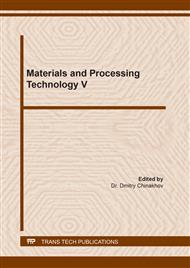[1]
Yu.D. Tretyakov, Development of inorganic chemistry as a fundamental basis for the creation of new generations of functional materials, Advances in Chemistry. 73 (2004) 899-916.
Google Scholar
[2]
A.D. Pomogaylo, A.S. Rosenberg, G.I. Dzhardimalieva, Metal complexes as precursors of self-organized nanocomposites, Russian Chemical Journal. 53 (2009) 140-151.
Google Scholar
[3]
S.I. Pechenyuk, U.P. Semyshina, D.P. Domonov, N.L. Mikhailova, Synthesis and properties of double complex nitrates [Ni(NH3)6]3[Fe(CN)6]2 and [Ni(NH3)6]3[Cr(CNS)6]2, Russian Journal of Coordination Chemistry. 32 (2006) 597-599.
DOI: 10.1134/s1070328406080070
Google Scholar
[4]
S.I. Pechenyuk, D.P. Domonov, D.L. Rogachev, A.T. Beluaevskiy, Of the influence of the anion nature to the thermolysis of double [Co(NH3)6]3[Fe(CN)6]2и [Co(NH3)6]3[Cr(CNS)6]2 complexes, Russian Journal of Inorganic Chemistry. 52 (2007) 1110-1115.
DOI: 10.1134/s0036023607070108
Google Scholar
[5]
A.D. Pomogaylo, A.S. Rosenberg, G.I. Dzhardimalieva, The thermolysis of metal polymers and their precursors as the method for nanocomposite production, Russian Chemical Reviews. 80 (2011) 272-285.
Google Scholar
[6]
D.P. Domonov, Research in pyrolytic decomposition of double complex first-transition-row metal compounds, Synopsis of a Candidate of chemical science thesis, Novosiberia, (2009).
Google Scholar
[7]
L.K. Neudachina, N.V. Lakiza, Physicochemical foundations of the use of coordination compounds, UrFU, Yekaterinburg, (2014).
Google Scholar
[8]
V.Ya. Khentov, V.V. Semchenko, Ye.Yu. Shachneva, Complexation processes of natural and technogenic origin, SCIence, Moscow, (2020).
Google Scholar
[9]
Kozo Sane, Yutaka Fukuda, Inorganic Thermochromism, Tokyo, Japan, (1987).
Google Scholar
[10]
B.G. Abramovich, Temperature sensors and their application, Energy, Moscow, (1972).
Google Scholar
[11]
B.G. Abramovich, V.F. Kartavtsev, Color indicators of temperature, Energy, Moscow, (1978).
Google Scholar
[12]
Y.N. Kukushkin, Higher order compounds, Chemistry, Leningrad, (1991).
Google Scholar
[13]
T.G. Cherkasova, E.S. Tatarinova, V.S. Cherkasov, Thermochromic effect in tetra(isorhodanate)chromate (III) in complexes with neutral organic ligands, Russian Journal of Inorganic Chemistry. 39 (1994) 1483-1485.
Google Scholar
[14]
G.M. Brauer, Guidance on inorganic synthesis, World, Moscow, (1985).
Google Scholar
[15]
Information on http://www.alhimik.ru/kunst/synt07.html.
Google Scholar
[16]
G.М. Sheldrick. SADABS. Version 2.01. Bruker AXS Inc. Madison, Wisconsin, USA, (2004).
Google Scholar
[17]
G.М. Sheldrick. Crystal structure refinement with SHELXL, Acta Crystallogr. 71 (2015) 3-8.
Google Scholar
[18]
E.V. Cherkasova, A.V. Virovets, E.V. Peresypkina, N.V. Podberezskaya, T.G. Cherkasova, Octakis(ε-caprolactam-kO)erbium(III)hexaisothiocyanatochromate(III), Acta Crystallogr. Sect. C: Cryst. Struct. Comm. 63 (2007). 195-198.
DOI: 10.1107/s0108270107015181
Google Scholar
[19]
I.V. Borovlyov, Organic Chemistry: terms and main reactions, BINOM, Knowledge Laboratory, Moscow, (2010).
Google Scholar
[20]
V.Y. Denisov, D.L. Myryshkin, T.V. Chuykova, Organic Chemistry, High School, Moscow, (2009).
Google Scholar
[21]
J. Clayden, N. Greeves, S. Warren. Organic Chemistry, Oksford, (2012).
Google Scholar
[22]
A. Terney, Modern Organic Chemistry, World, Moscow, (1981).
Google Scholar
[23]
A.V. Virovets, E.V. Peresypkina, E.V. Cherkasova, T.G. Cherkasova N.V. Podberezskaya, Structural Types of Octa (ε-Caprolactam) lantanide (III) Hexa(Isothiocyanato)Chromates (III). Phase Transition with Reversible Twinning, J. Struct. Chem. 50 (2009). 137-148.
DOI: 10.1007/s10947-009-0018-y
Google Scholar
[24]
R.G. Parrand R.G. Pearson, Absolute Hardness: Companion Parameter to Absolute Electronegativity, Journal of the American Chemical Society, 105 (1983) 7512-7516.
DOI: 10.1021/ja00364a005
Google Scholar
[25]
D. Shraiver, P. Etkins, Inorganic chemistry, Moscow, Mir, 2004. Vol. 1,2.
Google Scholar
[26]
A.D. Garnovskiy, A.P. Sadimenko, O.A. Osipov, G.V. Tsintsadze. Hard-soft interactions in coordination chemistry, Rostov-on-Don University, Rostov-on-Don, (1986).
Google Scholar
[27]
V.N. Ikorsky, A.S. Bogomyakov, Magnetochemistry, Institute International Tomographic Center, of SB of RAS, Novosibirsk, (2013).
Google Scholar
[28]
Yu.V. Rakitin, V.T. Kalinnikov, Modern magnetochemistry, Science, St. Petersburg, (1994).
Google Scholar
[29]
N.V. Kudrevatykh, A.S. Loginov, Magnetism of rare earth metals and their intermetallic compounds, UrFU, Yekaterinburg, (2015).
Google Scholar


